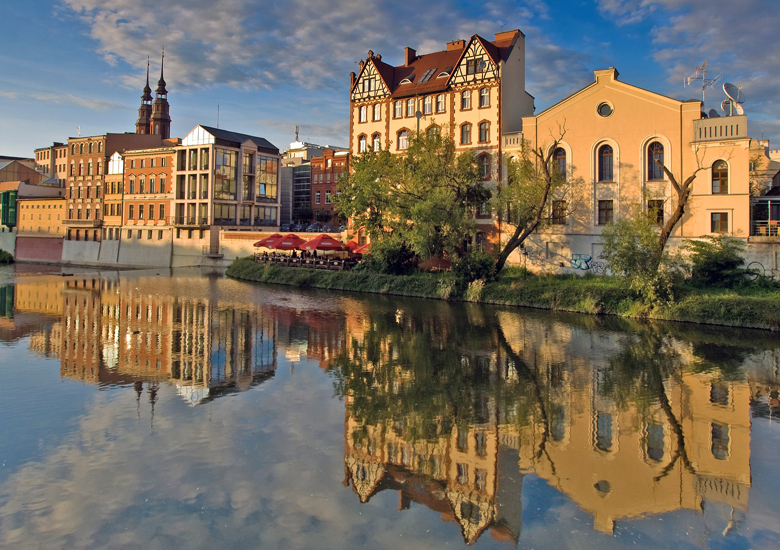Opole is a city located in southern Poland on the Oder River, it is the capital of the Opole Voivodeship and, also the seat of Opole County.
With it long history dating back to the 9th century, Opole is considered to be one of the oldest towns in Poland. The origins of the first settlement are connected with the town being granted Magdeburg Rights in 1217 by Casimir I of Opole, the great-grandson of Polish Duke Boleslaw III Wrymouth. During the Medieval Period and the Renaissance the city was known as a centre of commerce due to its position on the intersection of several main trade routes, which helped to generate steady profits from transit trade. The rapid development of the town was also caused by the establishment of a seat of regency in Opole in 1816. The first railway connection between Opole, Brzeg and Wroclaw was opened in 1843 and the first manufacturing plants were constructed in 1859, which greatly contributed to the city’s regional significance.
During its existence Opole belonged to Poland, Bohemia, Prussia and Germany. Prior to World War II it was located in eastern Germany and was one of the largest centres of Polish minority in the entire country. In 1945 the region fell into the Soviet Occupation Zone of Germany. They subsequently assigned it to Poland. It fell under no legal agreement. Many German Upper Silesians and Poles of German ancestry still live in the Opole region; in the city itself, however, ethnic Germans today make up less than 3% of the population following the 1945-6 expulsions. It was also the capital of the former German region of Upper Silesia.
Today there are four higher education establishments in the city: The Opole University, Opole University of Technology, a Medical College and the private Higher College of Management and Administration. The National Festival of Polish Song has been held here annually since 1963 and each year new regular events, fairs, shows and competitions take place. Opole is sometimes referred to as “Polish Venice”, because of its picturesque Old Town and several canals and bridges connecting parts of the city
Main sights : Piast tower, built under Bolko I of Opole, circa 1300
Opole hosts the annual National Festival of Polish Song. The city is also known for its 10th-century Church of St. Adalbert and the 14th-century Church of the Holy Cross. There is a zoo, the Ogrod Zoologiczny w Opolu.
Structures and buildings The 17th-century Castle in Moszna
Piast tower on the island (only part that remained of Piast castle)
a 14th-century Franciscan church, a Piast mausoleum , a 19th-century Town Hall
the Church of our Lady of Sorrows and St. Adalbert (Kosciol Matki Boskiej Bolesnej i sw. Wojciecha) the 14th-century Holy Cross Cathedral (Bazylika katedralna Podwyzszenia Krzyza Swietego) The art nouveau Penny Bridge (Most Groszowy), currently named Green Bridge (Zielony Mostek) Opole Main Station, an eclectic building from early 20th century. Museums
Diocesan Museum (Muzeum Diecezjalne) Opole Regional Museum (Muzeum Slaska Opolskiego) Opole Village Museum (Muzeum Wsi Opolskiej) Cemeteries , The Jewish Cemetery in Opole was established in 1822, and it is a peculiar pantheon of the Jews of Opole.
Acces : By plane : International airports are located in the nearby cities of Katowice and Wroclaw.
By bus : Opole has seen many of the inhabitants of the city and the region emigrate temporarily or permanently to Western Europe seeking better-paid jobs, especially concerning low-skilled, manual labour. One of the largest coach operators in Poland, Sindbad, is based in Opole and thus the city features in many of their timetables
PolskiBus runs a connection via Opole from Berlin and its Schoenefeld Airport through Wroclaw further to Katowice, Krakow and Zakopane. The journey from the farthest ends of the route to Opole takes 5 hours.
By train : The city’s main train station is 1 Opole Glowne, situated on a railway mainline to Wroclaw.
Wroclaw – 45 minutes , Czestochowa – 50 minutes , Katowice – 1h15mins , Walbrzych -1h40mins , Krakow – 2h25mins , Jelenia Gora – 2h40mins , Warsaw – 3 hours , Rzeszow 5h40mins , Szczecin – 6 hours , See the PKP Intercity interactive timetable for details on trains and times.
By car : You can easily get there by car from Katowice and Wroclaw by the A4 Motorway.
Main attractions : Piast Tower , Holy Trinity Church. A 14th century Franciscan church including a Piast mausoleum , Church on the Hill , Train station. Eclectic train station building , Most Groszowy. The pedestrian bridge with wrought iron railings was constructed at the turn of the 20th century ,Castle Pond with fountains ,Ceres Fountain, Plac Daszynskiego ,Venice of Opole. A wall of historic buildings directly over the Mlynowka river , Saint Sebastian Church , Opole Regional Museum , Opole Open-Air Museum of Rural Architecture (Muzeum Wsi Opolskiej), ul. Wroclawska 174. 10 / 5 zl, Mondays free , Modern Art Gallery , Song Museum (Muzeum Polskiej Piosenki) (at the Amphiteatre / National Centre of Polish Song)
Activities : Tour at the Piast Tower , Tour the Outdoor Museum , Visit Opole Zoo , Put a love lock on the city’s most famous bridge , visit the impressive Cathedral of the Holy Cross , Cruise the River Oder.

